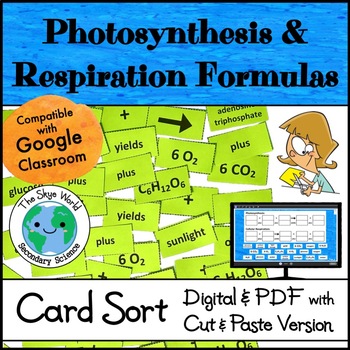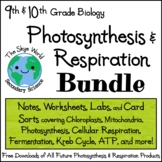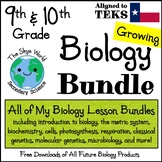Card Sort - Photosynthesis & Cellular Respiration Formulas - Digital & PDF
- PDF
- Internet Activities
- Easel Activity
Also included in
- This bundle of lessons will prepare students to differentiate between the processes of photosynthesis and cellular respiration. By completing these activities, 9th and 10th grade biology students will learn how to identify structures in the mitochondria and chloroplasts, break down the formulas, undPrice $16.00Original Price $24.00Save $8.00
- This growing bundle of lessons for 9th and 10th grade biology includes the metric system, biochemistry, cells, photosynthesis, respiration, cell division, heredity, and classical genetics. Bundles include notes, worksheets, lab activities, card sorts, task cards, digital Boom cards, review sheets,Price $191.00Original Price $317.00Save $126.00
Description
This card sort on photosynthesis and cellular respiration formulas will prepare your 7th grade science and 9th and 10th grade biology students to compare and identify the chemical reaction reactants and products by name, molecular formula, and number. Includes adenosine triphosphate (ATP), glucose, and carbon dioxide. Digital, online version included for distance learning.
Important Information
- includes Easel digital version that is Google Classroom compatible
- Answer key and student chart for interactive notebook included
- Recommended for 7th grade science and 9thand 10th grade biology
How it Works
- Students will sort a deck of cards into groups.
- Students will fill in a chart with the information after you go over the answer.
- Walk around and monitor student progress to check for understanding.
- Have students keep the chart out so you can record this as a daily grade.
TEKS Covered
7.5A
B.9B
NGSS Standards Covered
MS-LS1-6
MS-LS1-7
HS-LS1-5
HS-LS2-5
Materials Needed
Card stock (white or light colors), scissors, rubber bands
Also found in this money saving bundle
- 9th and 10th Grade Biology Growing Bundle of Lessons
- Bundle of Lessons – Photosynthesis and Cellular Respiration
Related Resources
- Notes – Photosynthesis and Cellular Respiration
- Lab – Alcoholic Fermentation
- Crossword Puzzles – Photosynthesis + Cellular Respiration
Acknowledgements
- Thank you to Ron Leishman Digital Toonage for the commercial right to use his clipart. Click here to visit his creative TpT site.
- Thank you to Sarah Pecorino Illustration for the commercial right to use her clipart. Click here to visit her wonderful TpT site.
Terms of Use – copyright ©Catherine Skye All rights to this product are reserved by author. This authorizes one teacher to use this product. If you want to share it with other teachers, please purchase a license to share this work. Copying by more than one teacher, classroom, department, school, or school system is prohibited UNLESS you purchase a license. Clipart and elements found in this PDF and others on my site are from the public domain unless otherwise noted. All products on my site are intended for classroom and personal use and may not be digitally copied for reuse in any form. Any misuse is considered copyright infringement and violates the DMCA (Digital Millennium Copyright Act).








